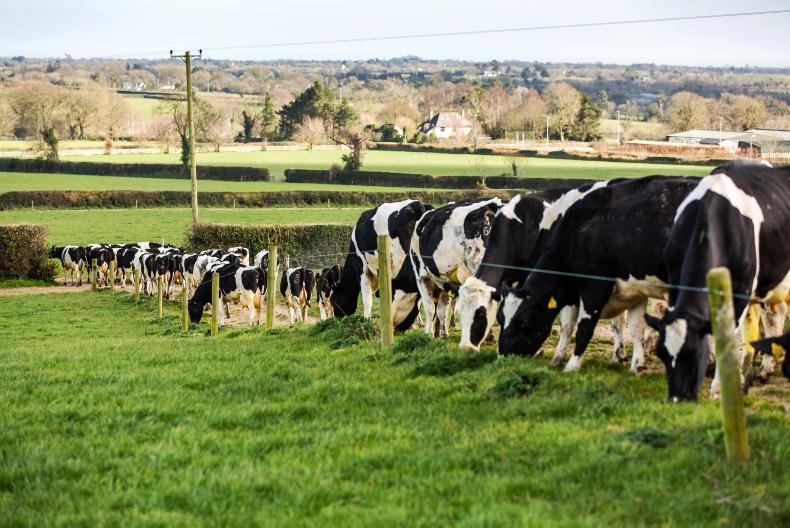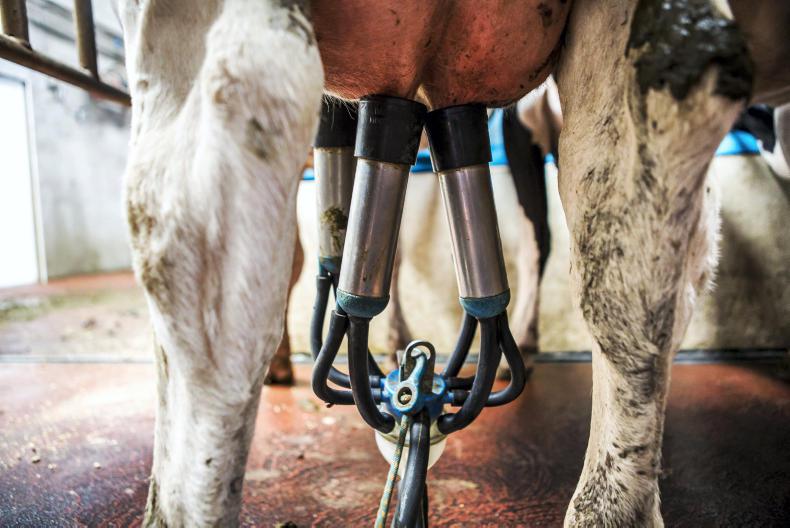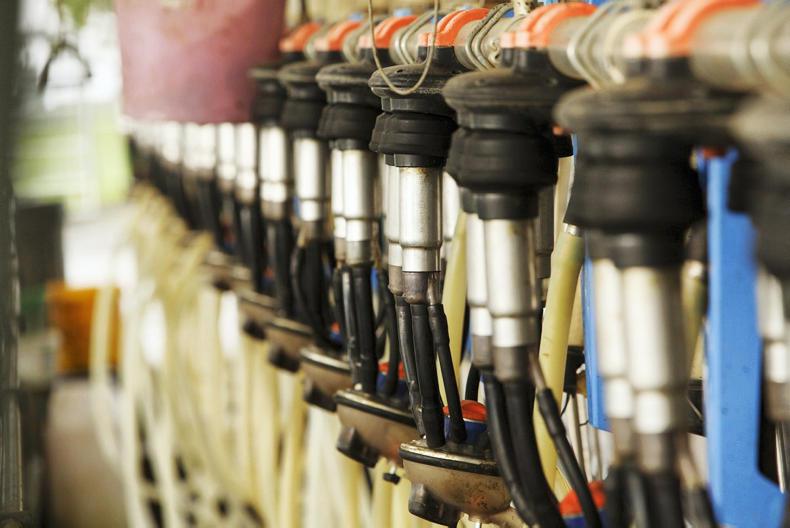Some fixed milk price contracts have compounded the challenges faced this spring by many farmers.
The Irish Farmers Journal spoke to a number of milk suppliers this week who have a portion of their milk pool tied into fixed milk price contracts.
All of the farmers said they know they signed up to the contracts and their terms, but have called for safeguards and clauses to be put in place in future contracts to deal with unprecedented events and skyrocketing input costs.
‘We made the decision
with our eyes open’
Milk supply: 2.4m litres, 900,000l of which is fixed.
Fixed milk price: 36c/l, but if solids are higher the price increases.
“I’m involved in three or four different contracts. If I didn’t have my milk fixed, I’d have made another €37,898 in March. I left it after me, about 13c/l on the contracted milk.
“The contracts were designed to take a bit of volatility. We joined to take a bit of the volatility out of it for fear that the milk price would drop.
“We said if we tie up a share of our milk and lose on it, at least we’re getting a good price for the rest. That was true up until this year. Jesus Christ if anyone said you’d be getting nearly 60c/l for March milk, they’d say in the name of God are you mad?
“There should be a lot of clauses in the contracts; if the price goes up 5c/l then the contract price should go up – the price should always be within 4/5c/l.
“We thought this was sound business. We’re not blaming [the processor], we made the decision with our eyes wide open.

\ Philip Doyle
“If we’re leaving say 14c/l after us for the year, with 900,000l that’s €126,000. Would I go back in? Not a hope in hell, not unless there was a clause.
“If we weren’t as secure as we were and if we had a lot of bank borrowings, this contract could very easily break us. It’s some belt to get.”
‘My accountant and bank
manager advised me a contract was the safest thing to do’
Milk supply: 480,000l, 378,000l of which is fixed.
Fixed milk price: From 32.8c/l to 42.6c/l.
“My accountant and bank manager advised me that the safest thing to do was put my milk into a fixed price contract. Volatility was a huge problem and we didn’t know how Brexit was going to go.
“I’ve 70% of my milk tied in, 378,000l out of a total of 480,000l. I had loan repayments, kids in university and home help for my elderly mother to pay. I was trying to put a percentage of milk away so I could pay the bills every year. I wanted to be safe.

“None of the lads I’ve spoken to are blaming anyone, but this cannot happen again. Last month, I lost €3,800. My total supply was 38,000l and I was 10c/l behind the average milk price at average constituents.
“I didn’t make enough in the month to cover the cost of production. My only saving grace is that my wife has a really good job and she is supporting me at the moment.
“It’s probably a once in a lifetime issue, it was naïve of me, I put my hands up. I trusted our co-op board to negotiate a safe package. There is no get-out clause.
“This isn’t a vendetta against anyone, it was a contract … but buyer beware. If milk price hits 50c/l, I’ll lose €42,000 this year, if it stays around 47.1c/l, I’ll lose €36,000. We’re locked in until October.
“The only way I’d go back into a contract is if there is a clause with a defined margin over cost. The price you get is immaterial, the margin you make out of the product is what you need.”
‘Future contracts need to link the price to input costs’
Milk supply: 800,000l.
Fixed milk: 480,000l or 60% of
total.
Average fixed price: 38.8c/l.
“I estimate that the price I received for my milk so far this year is around 9c/l below the actual price that is available,” this farmer told the Irish Farmers Journal.
“Because I have around 60% of my milk tied into fixed schemes, the cost to me this year will be around €35,000. That is a serious amount of money.
“Older farmers like myself will be able to work through this, although we are working for next to nothing, but younger lads with debt could be put in a right hole,” he added.
The only positive is that a lot of his fixed milk falls out of contract in June.
“That’s the one good thing about these short-term contracts,” he maintained.

Will he join another fixed-price contract?
“Absolutely not. If fixed-milk-price contracts are to exist into the future there will have to be safeguards put in place for farmers. These will have to link the contract price to the cost of inputs,” he insisted.
He claimed that the fixed-price concept had been “severely damaged” by the difficulties that have arisen this year.
He accepted that farmers were not forced to join the fixed milk price schemes, but he said some allowance had to be made for the “unprecedented events” of this year.
“Inflation has stayed flat for the last 10-15 years, and there hasn’t been a major war in Europe since 1945,” he pointed out.
“The purchasers of the milk under these contracts are making huge profits. But farmers are being forced to carry reduced milk prices at a time when the cost of feed and fertiliser has reached record levels. This situation needs to be addressed.”
‘I took on the contracts,
and I got a bad result’
Milk supply: 250,000 litres.
Fixed milk: 90% of March supplies was fixed.
Another farmer told the Irish Farmers Journal that fixed milk contracts were costing his business around €1,000/month at the moment and are likely to take €700/month on average out of his milk cheques this year.
“The lost income will come to €3,500 by July. I have feed and fertiliser in the yard that has yet to be paid for, and I have a significant vet bill as well. That €3,500 would have been very useful this summer if I had it,” he said.
“I can’t blame [the processor] for this. I took on the contracts, and I got a bad result,” he admitted.
“These contracts were supposed to help farmers by stabilising matters, but they have not worked this year.”
“I can hang on this year, although I am taking a fair hammering at the moment. But what do I do for 2023? Do I just give up and get out,” he asked.
He echoed the views of other dairy farmers and insisted that the fixed-price contracts will have to be tweaked so that farmers are not exposed to the same level of losses experienced this year.
“There will have to be a lot of thought put into the restructuring of the schemes to restore farmer confidence in them,” he maintained.
‘Farmers left swinging in the breeze’
Milk supply: 700,000 litres
Fixed milk: None
“I was one of the lucky ones. I have been in fixed-price schemes over the last three to four years, but I dropped out of them last year. That was more through good fortune than design,” one farmer said.
“There are some real horror stories around, with people having up to 70% of milk supplies tied in. There are a lot of people climbing the walls because of this problem. Farmers who are heavily borrowed, or are tied into expensive long-term leases, are particularly exposed.
“The processors and banks have promoted fixed-price contracts, but they have all walked away and left farmers swinging in the breeze this spring. There is nothing wrong with the concept of fixed-price contracts but there has to be a lot more clarity for farmers around the pitfalls. There also has to be some linkage with the cost of key inputs such as fertiliser, feed and diesel.”
The farmers the Irish Farmers Journal spoke to did not wish to be named.
Some fixed milk price contracts have compounded the challenges faced this spring by many farmers.
The Irish Farmers Journal spoke to a number of milk suppliers this week who have a portion of their milk pool tied into fixed milk price contracts.
All of the farmers said they know they signed up to the contracts and their terms, but have called for safeguards and clauses to be put in place in future contracts to deal with unprecedented events and skyrocketing input costs.
‘We made the decision
with our eyes open’
Milk supply: 2.4m litres, 900,000l of which is fixed.
Fixed milk price: 36c/l, but if solids are higher the price increases.
“I’m involved in three or four different contracts. If I didn’t have my milk fixed, I’d have made another €37,898 in March. I left it after me, about 13c/l on the contracted milk.
“The contracts were designed to take a bit of volatility. We joined to take a bit of the volatility out of it for fear that the milk price would drop.
“We said if we tie up a share of our milk and lose on it, at least we’re getting a good price for the rest. That was true up until this year. Jesus Christ if anyone said you’d be getting nearly 60c/l for March milk, they’d say in the name of God are you mad?
“There should be a lot of clauses in the contracts; if the price goes up 5c/l then the contract price should go up – the price should always be within 4/5c/l.
“We thought this was sound business. We’re not blaming [the processor], we made the decision with our eyes wide open.

\ Philip Doyle
“If we’re leaving say 14c/l after us for the year, with 900,000l that’s €126,000. Would I go back in? Not a hope in hell, not unless there was a clause.
“If we weren’t as secure as we were and if we had a lot of bank borrowings, this contract could very easily break us. It’s some belt to get.”
‘My accountant and bank
manager advised me a contract was the safest thing to do’
Milk supply: 480,000l, 378,000l of which is fixed.
Fixed milk price: From 32.8c/l to 42.6c/l.
“My accountant and bank manager advised me that the safest thing to do was put my milk into a fixed price contract. Volatility was a huge problem and we didn’t know how Brexit was going to go.
“I’ve 70% of my milk tied in, 378,000l out of a total of 480,000l. I had loan repayments, kids in university and home help for my elderly mother to pay. I was trying to put a percentage of milk away so I could pay the bills every year. I wanted to be safe.

“None of the lads I’ve spoken to are blaming anyone, but this cannot happen again. Last month, I lost €3,800. My total supply was 38,000l and I was 10c/l behind the average milk price at average constituents.
“I didn’t make enough in the month to cover the cost of production. My only saving grace is that my wife has a really good job and she is supporting me at the moment.
“It’s probably a once in a lifetime issue, it was naïve of me, I put my hands up. I trusted our co-op board to negotiate a safe package. There is no get-out clause.
“This isn’t a vendetta against anyone, it was a contract … but buyer beware. If milk price hits 50c/l, I’ll lose €42,000 this year, if it stays around 47.1c/l, I’ll lose €36,000. We’re locked in until October.
“The only way I’d go back into a contract is if there is a clause with a defined margin over cost. The price you get is immaterial, the margin you make out of the product is what you need.”
‘Future contracts need to link the price to input costs’
Milk supply: 800,000l.
Fixed milk: 480,000l or 60% of
total.
Average fixed price: 38.8c/l.
“I estimate that the price I received for my milk so far this year is around 9c/l below the actual price that is available,” this farmer told the Irish Farmers Journal.
“Because I have around 60% of my milk tied into fixed schemes, the cost to me this year will be around €35,000. That is a serious amount of money.
“Older farmers like myself will be able to work through this, although we are working for next to nothing, but younger lads with debt could be put in a right hole,” he added.
The only positive is that a lot of his fixed milk falls out of contract in June.
“That’s the one good thing about these short-term contracts,” he maintained.

Will he join another fixed-price contract?
“Absolutely not. If fixed-milk-price contracts are to exist into the future there will have to be safeguards put in place for farmers. These will have to link the contract price to the cost of inputs,” he insisted.
He claimed that the fixed-price concept had been “severely damaged” by the difficulties that have arisen this year.
He accepted that farmers were not forced to join the fixed milk price schemes, but he said some allowance had to be made for the “unprecedented events” of this year.
“Inflation has stayed flat for the last 10-15 years, and there hasn’t been a major war in Europe since 1945,” he pointed out.
“The purchasers of the milk under these contracts are making huge profits. But farmers are being forced to carry reduced milk prices at a time when the cost of feed and fertiliser has reached record levels. This situation needs to be addressed.”
‘I took on the contracts,
and I got a bad result’
Milk supply: 250,000 litres.
Fixed milk: 90% of March supplies was fixed.
Another farmer told the Irish Farmers Journal that fixed milk contracts were costing his business around €1,000/month at the moment and are likely to take €700/month on average out of his milk cheques this year.
“The lost income will come to €3,500 by July. I have feed and fertiliser in the yard that has yet to be paid for, and I have a significant vet bill as well. That €3,500 would have been very useful this summer if I had it,” he said.
“I can’t blame [the processor] for this. I took on the contracts, and I got a bad result,” he admitted.
“These contracts were supposed to help farmers by stabilising matters, but they have not worked this year.”
“I can hang on this year, although I am taking a fair hammering at the moment. But what do I do for 2023? Do I just give up and get out,” he asked.
He echoed the views of other dairy farmers and insisted that the fixed-price contracts will have to be tweaked so that farmers are not exposed to the same level of losses experienced this year.
“There will have to be a lot of thought put into the restructuring of the schemes to restore farmer confidence in them,” he maintained.
‘Farmers left swinging in the breeze’
Milk supply: 700,000 litres
Fixed milk: None
“I was one of the lucky ones. I have been in fixed-price schemes over the last three to four years, but I dropped out of them last year. That was more through good fortune than design,” one farmer said.
“There are some real horror stories around, with people having up to 70% of milk supplies tied in. There are a lot of people climbing the walls because of this problem. Farmers who are heavily borrowed, or are tied into expensive long-term leases, are particularly exposed.
“The processors and banks have promoted fixed-price contracts, but they have all walked away and left farmers swinging in the breeze this spring. There is nothing wrong with the concept of fixed-price contracts but there has to be a lot more clarity for farmers around the pitfalls. There also has to be some linkage with the cost of key inputs such as fertiliser, feed and diesel.”
The farmers the Irish Farmers Journal spoke to did not wish to be named.












SHARING OPTIONS